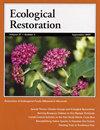We Built It; Did They Come? Pollinator Diversity and Community Structure in a Post-Mining Prairie Restoration Project
IF 1.1
4区 环境科学与生态学
Q2 ECOLOGY
引用次数: 0
Abstract
ABSTRACT More than 2.5 million hectares have been impacted by coal mining in the Appalachian region of the United States. Revegetation to forested cover is a desirable post-mining land use but is often impractical given the challenges of reforestation on abandoned coal mines. Considering a prospective pollination crisis and the potential value of habitat restoration for pollinators, prairie restoration on mine lands offers a practical restoration option. We tested the effect of native prairie restoration in comparison to traditional reclamation with non-native cool-season grassland on pollinator richness, diversity, and community structure at three mined sites in southeastern Ohio. Rather than treatment level effects, we found correlations between overall floral and pollinator richness and beta diversity, as well as varied pollinator diversity and distinct community composition by month. Therefore, judicious design of prairie restoration seed mixes could increase floral diversity and provide across-season forage for pollinators in post-mining landscapes. Our findings also suggest, by the presence of several specialist/uncommon pollinators, that prairie restorations on coal mines can provide habitat for at-risk pollinators.我们建造了它,它们来了吗?采矿后草原恢复项目中的授粉者多样性和群落结构
摘要 美国阿巴拉契亚地区有 250 多万公顷的土地受到煤矿开采的影响。重新植被为森林覆盖是一种理想的采矿后土地利用方式,但由于在废弃煤矿上重新造林所面临的挑战,这种方式往往不切实际。考虑到未来的授粉危机以及恢复授粉者栖息地的潜在价值,在矿区土地上恢复草原提供了一种实用的恢复方案。我们在俄亥俄州东南部的三个矿区测试了原生草原恢复与传统的非原生冷季型草地复垦对传粉昆虫丰富度、多样性和群落结构的影响。我们发现,整体花卉和授粉昆虫丰富度与β多样性之间存在相关性,授粉昆虫多样性和独特的群落组成也因月而异,而非处理水平效应。因此,明智地设计草原恢复混合种子可以增加花卉多样性,并为采矿后景观中的传粉昆虫提供跨季节饲料。我们的研究结果还表明,通过几种特殊/不常见传粉昆虫的存在,煤矿上的草原恢复可以为濒危传粉昆虫提供栖息地。
本文章由计算机程序翻译,如有差异,请以英文原文为准。
求助全文
约1分钟内获得全文
求助全文
来源期刊

Ecological Restoration
Environmental Science-Nature and Landscape Conservation
CiteScore
1.70
自引率
12.50%
发文量
24
期刊介绍:
Ecological Restoration is a forum for people advancing the science and practice of restoration ecology. It features the technical and biological aspects of restoring landscapes, as well as collaborations between restorationists and the design professions, land-use policy, the role of education, and more. This quarterly publication includes peer-reviewed science articles, perspectives and notes, book reviews, abstracts of restoration ecology progress published elsewhere, and announcements of scientific and professional meetings.
 求助内容:
求助内容: 应助结果提醒方式:
应助结果提醒方式:


